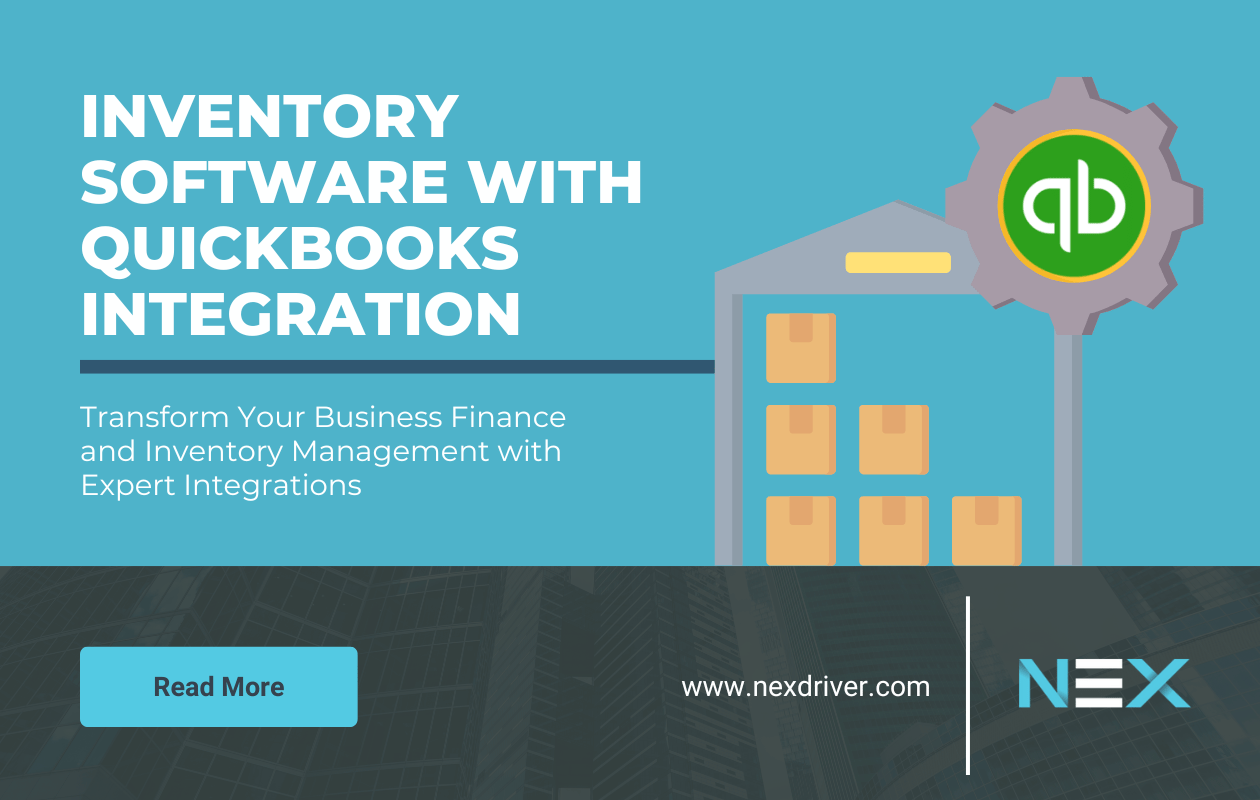1 min read
Best Inventory Management Software Integrations with QuickBooks
Integrating QuickBooks with specialized inventory management software is becoming a strategic decision for many businesses looking to enhance the...
6 min read
NEX Marketing : Mar 5, 2024 8:29:48 AM

Did you know that the average inventory accuracy level for US retail operations is a mere 63%? This startling figure highlights a significant challenge in the finance sector, particularly for technology leaders who are navigating the complexities of inventory management. Such a low accuracy rate not only leads to stockouts and negative customer experiences but also highlights the critical need for robust inventory management software. Implementing such systems can dramatically improve logistics costs by 15%, inventory levels by 35%, and service levels by 65% compared to competitors lagging behind in technology adoption.
TL;DR Summary:
This blog post dives into the indispensable role of inventory management software in modern business operations, particularly for those in the finance sector facing the challenge of low inventory accuracy rates. It emphasizes the software’s ability to prevent stockouts and overstocking, thereby enhancing customer satisfaction and operational efficiency. Key takeaways include the importance of selecting scalable, integrable, and user-friendly software; the necessity of comprehensive training and effective data migration for successful software adoption; and the critical role of seamless integration with existing systems. Through a detailed exploration of these aspects, the post provides valuable insights for technology leaders looking to optimize inventory management processes and navigate the complexities of the global supply chain.
Implementing inventory management software is crucial for businesses to effectively manage their inventory. It provides real-time visibility into stock levels, streamlines order fulfillment processes, and helps optimize inventory holding costs. By understanding the importance of inventory management software, businesses can better appreciate the need for its successful implementation.
One of the main benefits of inventory management software is its ability to prevent stockouts and overstocking. By accurately tracking inventory levels and sales data, businesses can ensure they have the right amount of stock on hand to meet customer demand. This leads to improved customer satisfaction and avoids the loss of potential sales.
The average inventory accuracy level in US retail operations is only 63%, leading to stockouts and negative customer experiences. Improving accuracy through inventory management software helps prevent these issues, ensuring that businesses can meet customer demand efficiently.
Research indicates that 87% of supply chain professionals plan to invest in resilience over the next two years, highlighting the need for businesses to adapt to supply chain disruptions and recover quickly. The adoption of AI and IoT technologies has enabled businesses to improve logistics costs by 15%, inventory levels by 35%, and service levels by 65% compared to slower-moving competitors.
Inventory management software allows for better forecasting and demand planning, ensuring that inventory is ordered and replenished at the right time. This prevents excess inventory and reduces carrying costs. Additionally, it helps identify slow-moving or obsolete inventory, allowing businesses to take necessary actions to minimize losses.
Furthermore, inventory management software provides valuable insights into sales trends and inventory performance. It generates reports and analytics that help businesses make informed decisions about purchasing, pricing, and inventory allocation. By understanding which products are selling well and which ones are underperforming, businesses can adjust their strategies and improve overall profitability.
Overall, understanding the importance of inventory management software is crucial for businesses looking to streamline their operations, improve customer satisfaction, and optimize their inventory management processes.
Selecting the right inventory management software is a critical decision that can greatly impact a business's operations. With numerous options available in the market, businesses need to carefully evaluate their requirements and consider several factors before making a choice.
One key factor to consider is scalability. The chosen software should be able to accommodate the business's current inventory needs while also allowing room for future growth. It should be able to handle increasing sales volumes, expanding product lines, and additional warehouse locations.
With the global supply chain industry worth $15.85 billion and expected to grow significantly, the scalability and integration capabilities of inventory management software become increasingly important. Popular platforms like NetSuite, NEX, Odoo, and Brightpearl are examples of systems that offer comprehensive solutions to manage inventory efficiently
Integration capabilities are another important consideration. The inventory management software should be able to seamlessly integrate with existing systems, such as accounting software (e.g. QuickBooks), ecommerce platforms (e.g. Shopify), and shipping providers. This ensures smooth data flow across different departments and avoids the need for manual data entry or duplicate records.
Ease of use and user-friendliness are also crucial factors. The software should have an intuitive interface and provide easy navigation and access to key features. This reduces the learning curve for staff and increases productivity.
Additionally, businesses should evaluate the software's reporting and analytics capabilities. It should provide comprehensive and customizable reports that provide insights into inventory levels, sales trends, and other key metrics.
Implementing new inventory management software requires proper training and onboarding of staff to ensure its successful adoption and utilization. It is essential to invest time and resources in training to maximize the benefits of the software.
First of all, businesses should provide comprehensive training sessions to familiarize staff with the software's features and functionalities. This can be done through in-person training sessions, online tutorials, or a combination of both. The training should cover basic tasks such as inventory tracking, order management, and reporting.
Additionally, businesses should assign a dedicated support team or point of contact to assist staff with any questions or issues that may arise. This ensures that staff have the necessary support and guidance during the initial stages of using the software.
Furthermore, businesses should encourage staff to provide feedback on the software's usability and identify any areas for improvement. This feedback can be valuable in optimizing the software and addressing any user concerns.
By investing in proper training and onboarding, businesses can ensure that staff are equipped with the necessary skills and knowledge to effectively utilize the inventory management software, leading to improved efficiency and productivity.
When implementing inventory management software, businesses often face challenges related to data migration. Migrating data from existing systems or spreadsheets to the new software can be a complex process that requires careful planning and execution.
Data migration poses a variety of challenges that can impact the efficiency, accuracy, and overall success of the software implementation process. These challenges can range from technical issues to operational and strategic concerns. Here's a detailed look at some of these challenges:
1. Data Quality and Consistency
2. System Compatibility and Integration
3. Technical Expertise
4. Business Disruption
5. Security and Compliance
6. Cost Overruns
Additionally, businesses should consider the volume and complexity of their data when planning the migration. Large datasets or complex data relationships may require additional time and resources for a successful migration.
To mitigate these challenges, businesses should create a detailed data migration plan, allocate sufficient resources, and involve key stakeholders in the process. It is also advisable to perform thorough testing and validation of the migrated data to ensure its accuracy and completeness.
By addressing these data migration challenges proactively, businesses can ensure a smooth transition to the new inventory management software and avoid any disruptions to their operations.
Integrating the new inventory management software with existing systems is a critical aspect of its implementation. Seamless integration allows for efficient data flow across different departments and eliminates the need for manual data entry or duplicate records.
One common challenge is ensuring compatibility between the inventory management software and existing systems, such as accounting software, ecommerce platforms, and shipping providers. The software should have the necessary integration capabilities or provide APIs (Application Programming Interfaces) for smooth data exchange. Seamless integration is crucial for optimizing business operations and ensuring that information flows seamlessly between different departments. By enabling data synchronization and real-time updates, integration streamlines processes, minimizes errors, and enhances overall efficiency.
Additionally, integrating with existing systems allows for a centralized view of data, providing a holistic perspective on inventory levels, sales performance, and customer interactions. This interconnected approach fosters a more cohesive and streamlined operational environment, ultimately leading to improved decision-making and enhanced business performance.
By addressing integration challenges early on and ensuring seamless data flow between systems, businesses can optimize their operations and maximize the benefits of the inventory management software.
Reflecting on the initial revelation of a 63% inventory accuracy rate in US retail operations, it's evident that inventory management software is not just beneficial but essential for modern, growing businesses.
As we look ahead, the question remains: Will businesses embrace the advancements in inventory management software or continue with outdated methods, risking their competitive edge?
From personal experience, we've seen the significant impact of our customers adopting more robust inventory management systems firsthand. The transition marks a pivotal shift, enhancing customer engagement, employee satisfaction, and overall business performance.
Looking ahead, NEX stands as a partner ready to support businesses in taking inventory management to the next level. We invite you to explore the potential of NEX through a personalized demo, demonstrating how our platform can enhance your operational efficiency. Discover more at www.nexdriver.com/modules and get started with the future of inventory management with NEX.

1 min read
Integrating QuickBooks with specialized inventory management software is becoming a strategic decision for many businesses looking to enhance the...

1 min read
Picture your business running smoothly, with every item in its right place and your customers more satisfied than ever. This scenario isn't just...

Professionals overseeing supply chain management navigate product flow, warehouse optimization, and accurate financial records, yet shifting customer...